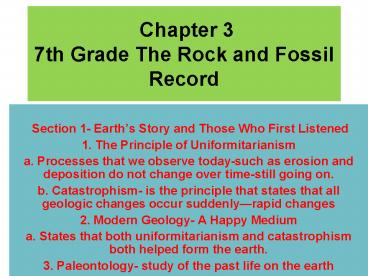Chapter 3 7th Grade The Rock and Fossil Record
1 / 9
Title: Chapter 3 7th Grade The Rock and Fossil Record
1
Chapter 3 7th Grade The Rock and Fossil Record
- Section 1- Earths Story and Those Who First
Listened - 1. The Principle of Uniformitarianism
- a. Processes that we observe today-such as
erosion and deposition do not change over
time-still going on. - b. Catastrophism- is the principle that states
that all geologic changes occur suddenlyrapid
changes - 2. Modern Geology- A Happy Medium
- a. States that both uniformitarianism and
catastrophism both helped form the earth. - 3. Paleontology- study of the past life on the
earth
2
- Section 2Relative Dating Which Came First
- Relative Dating- determining if an object is
older or younger than other objects. - 1. The Principle of Superposition
- a. The principle states younger rocks lie above
older rocks. - b. Disturbing Forces
- a. Forces change this by tilting, folding and
breaking into movable forces. - 2. The Geologic Columnarrangement of rock layers
in which oldest are at the bottom.
3
- 3. Disturbed Rock Layer
- a. Fault-break in the earths crust where blocks
of crust slide relative to each other - b. Intrusion- molten rock from the interior
squeezes into existing rock and cools. - c. Foldingwhen layers bend and buckle.
- d. Tilting-internal forces in the Earth slant
rock layers. - 4. Gaps in the Record-Unconformities
- a. Layers of rock missing completely
- b. Missing evidence- Unconformity is a surface
that represents a missing part in the geologic
column. - i. Nondeposition- stoppage of deposition when
sediment is cut off - 5. Types of Unconformities
- a. Disconformities
4
- Section 3Absolute Dating A Measure of Time
- Absolute Dating- telling the age of an object by
determining how long it has existed. - 1. Radioactive Decay
- a. Isotopes- an element with the same number of
protons, but a - different number of electrons.
- b. Most are stable, meaning they stay in their
normal form. Some are unstable. - c. Unstable isotopes are called radioactive
- 1. Parent isotope- unstable
- 2. Daughter isotope- stable isotope produced by
the decay of the parent isotope. - 2. Radiometric Dating
- a. based on the ratio of parent material to the
daughter material - b. half-life is the time it takes one half of a
radioactive sample to decay
5
Section 4Looking at Fossils
- Fossilized Organisms
- Fossil-remains or physical evidence of an
organism - Fossils in Rocks
- Hard parts of animals- shells bones
- Fossils in Amber
- Amber-hardened tree sap
- Petrification
- Minerals replace an organisms tissue
- Permineralization-the pore space (bone or wood)
is replaced by minerals
6
- Fossils in Asphalt
- LaBrea asphalt pits
- Frozen Fossils
- Preserved from the last ice age
- Other Types of Fossils
- Trace Fossils
- Naturally preserved evidence of animal activity
- Molds and Casts
- Mold cavity where the animal is buried
- Cast-an object created when sediment fills in a
mold. - Using Fossils to Interpret the Past
- The information in the Fossil Record
- Rough sketch of the history of life on earth
7
- History of Environmental Change
- Marine fossils on a mountain top
- History of Changing Organisms
- Only a small portion of animals have been
fossilized - Using Fossils to Date Rocks--Index Fossils are
fossils of organisms that lived in a very short
well defined geologic time span - Ammontes called Tropites index fossil of 230-208
million years ago. - Trilobites called Phacops 400 million years ago.
8
Section 5 Time Marches On
- Geologic Time
- The Rock Record and Geologic Time
- The Fossil Record and Geologic Time
- The Geologic Time Scale
- Divisions of Time
- Eons-largest- 4 of these
- Eras-second largest- 3 of them
- Periods-third largest
- Epochs-fourth largest
9
- The Appearance and Disappearance of Species
- Extinction-no longer living all of that species
are dead - The Paleozoic Era-Old Life
- The Mesozoic Era-The Age of Reptiles
- The Cenozoic Era- The Age of Mammals

